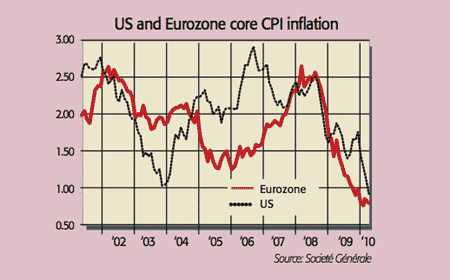
Suddenly, “words that had dropped out of investors’ vocabulary in recent months” have returned to the fore, says Aline van Duyn in the FT. In particular, “double-dip recession” and “deflation” are back.
The latest data bodes ill. In America, the Conference Board’s leading indicator declined in April. That was the first monthly drop since early 2009; the Economic Cycle research institute’s leading indicator is now at a ten-week low. And initial jobless claims jumped to a five-year high last week – to a level consistent with further falls in payrolls, says David Rosenberg of Gluskin Sheff. Note too that employment gains aren’t keeping up with the growth in the labour force. The unemployment rate has risen to 9.9% from 9.7% last month. Credit remains tight, with total commercial lending at US banks down by almost 25% in the past year and a half, says John Mauldin on Investorsinsight.com.
Nor is the picture in Europe any better. The rise in eurozone exports “is unlikely to offset the squeeze on domestic demand from tighter fiscal policy”, as Capital Economics points out. And the rise in interbank lending rates “could result in yet another European credit crisis”, with banks loathe to lend to each other due to the “interconnected holdings of ‘junk’ European government debt”, says Christopher Wood of CLSA. Poor or negative EU growth won’t help Britain’s private sector compensate for our own fiscal squeeze. Bank lending, according to David Owen of Jefferies, is now trending down again with quantitative easing having come to an end.
In a post-credit-bubble world, “recession follows recession with surprising rapidity”, says Albert Edwards of Société Générale. But the really worrying thing about the relapse-prone economy is that a double-dip would mean “Japanese-style outright deflation” in the West. Just as inflation reduces the real value of debt burdens, deflation increases them, which is the last thing our economies need, as deleveraging “still has years to run”.
In the US, core inflation (stripping out volatile energy and food prices) is at a 44-year low of 0.9%. In the eurozone the rate is 0.8%; Spain has just entered core deflation; Ireland’s overall CPI index has slid for 16 months. “The fundamental trend in the West remains profoundly deflationary,” says Wood. Get set for a “deflation scare” and new equity-market lows, says Edwards.